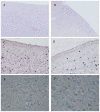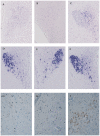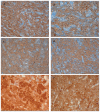Changes in CRH and ACTH synthesis during experimental and human septic shock
- PMID: 22073145
- PMCID: PMC3207830
- DOI: 10.1371/journal.pone.0025905
Changes in CRH and ACTH synthesis during experimental and human septic shock
Abstract
Context: The mechanisms of septic shock-associated adrenal insufficiency remain unclear. This study aimed at investigating the synthesis of corticotropin-releasing hormone (CRH) and vasopressin (AVP) by parvocellular neurons and the antehypophyseal expression of ACTH in human septic shock and in an experimental model of sepsis.
Objective: To test the hypothesis that ACTH secretion is decreased secondarily to alteration of CRH or AVP synthesis, we undertook a neuropathological study of the antehypophyseal system in patients who had died from septic shock and rats with experimental faecal peritonitis.
Methods: Brains obtained in 9 septic shock patients were compared to 10 nonseptic patients (controls). Parvocellular expression of AVP and CRH mRNA were evaluated by in situ hybridization. Antehypophyseal expression of ACTH, vasopressin V1b and CRH R1 receptors and parvocellular expression of iNOS in the PVN were evaluated by immunohistochemistry. The same experiments were carried out in a fecal peritonitis-induced model of sepsis. Data from septic rats with (n = 6) or without (n = 10) early death were compared to sham-operated (n = 8) animals.
Results: In patients and rats, septic shock was associated with a decreased expression of ACTH, unchanged expression of V1B receptor, CRHR1 and AVP mRNA, and increased expression of parvocellular iNOS compared to controls. Septic shock was also characterized by an increased expression of CRH mRNA in rats but not in patients, who notably had a greater duration of septic shock.
Conclusion: The present study suggests that in humans and in rats, septic shock is associated with decreased ACTH synthesis that is not compensated by its two natural secretagogues, AVP and CRH. One underlying mechanism might be increased expression of iNOS in hypothalamic parvocellular neurons.
Trial registration: ClinicalTrials.gov NCT00147004.
Conflict of interest statement
Figures




References
-
- Annane D, Sebille V, Troche G, Raphael JC, Gajdos P, et al. A 3-level prognostic classification in septic shock based on cortisol levels and cortisol response to corticotropin. JAMA. 2000;283:1038–1045. - PubMed
-
- Annane D, Aegerter P, Jars-Guincestre MC, Guidet B. Current epidemiology of septic shock: the CUB-Rea Network. Am J Respir Crit Care Med. 2003;168:165–172. - PubMed
-
- Martin GS, Mannino DM, Eaton S, Moss M. The epidemiology of sepsis in the United States from 1979 through 2000. N Engl J Med. 2003;348:1546–1554. - PubMed
-
- Schroeder S, Wichers M, Klingmuller D, Hofer M, Lehmann LE, et al. The hypothalamic-pituitary-adrenal axis of patients with severe sepsis: altered response to corticotropin-releasing hormone. Crit Care Med. 2001;29:310–316. - PubMed
-
- Muller MB, Preil J, Renner U, Zimmermann S, Kresse AE, et al. Expression of CRHR1 and CRHR2 in mouse pituitary and adrenal gland: implications for HPA system regulation. Endocrinology. 2001;142:4150–4153. - PubMed
Publication types
MeSH terms
Substances
Associated data
LinkOut - more resources
Full Text Sources
Other Literature Sources
Medical
Miscellaneous

